“Smoke, night, the dark lunar fortnight, and the six months of southern solstice of the sun; departing by these paths, the righteous person attains lunar light and reincarnates.”
– the Bhagavad Gita
Buenos Aires – What does one do to celebrate the Winter Solstice? In doing a bit of net surfing, I came across numerous customs, many of which had to do with food, but the gist of it all seemed to come down to – eat well, eat hearty, enjoy. I can get behind that… and here, we don’t have to run out and shovel snow after we eat. Life is good. Some of this weekend’s menu is based on recipes that I got from other chefs or sources… to be acknowledged as we go…
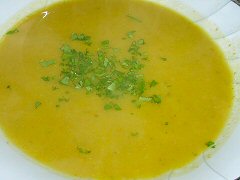 Looking for a traditional solstice soup, I came across the Chinese tradition of a dumpling or wonton soup… and originally I was going to use something in that vein as our first course. But when I looked at the menu as a whole, it just didn’t fit with anything else that we were having. Now, I happen to like a lot of what one might call “winter vegetables” – and one of my favorites is one of those most loathed… We kids feared many things in those days – werewolves, dentists, North Koreans, Sunday School – but they all paled in comparison with Brussels sprouts.” – Dave Barry, columnist – too bad, I was making them into a soup. I started with a recipe from an old McCall’s magazine… though because we had a couple of lactose intolerant folk coming on the first night I decided to eliminate the “2 cups of half and half” from the original recipe… in the end – I peeled and coarsely cut up a white onion, a red onion, and two carrots. Tossed them in a pot with roughly a pound of cleaned and trimmed brussels sprouts and cooked them in a little olive oil with just a touch of butter. When they were just starting to caramelize a bit I added a tablespoon of worcestershire sauce, about ½ cup of rose wine, some salt, pepper, and nutmeg, and topped it off with vegetable stock, brought it to a boil, reduced to a simmer, and cooked until the vegetables were soft. Then pureed in the blender, adjusted the seasoning, and served with some parsley scattered atop. Two different people told me they hated brussels sprouts but liked this soup, so if you’re one of those sort, give this a try!
Looking for a traditional solstice soup, I came across the Chinese tradition of a dumpling or wonton soup… and originally I was going to use something in that vein as our first course. But when I looked at the menu as a whole, it just didn’t fit with anything else that we were having. Now, I happen to like a lot of what one might call “winter vegetables” – and one of my favorites is one of those most loathed… We kids feared many things in those days – werewolves, dentists, North Koreans, Sunday School – but they all paled in comparison with Brussels sprouts.” – Dave Barry, columnist – too bad, I was making them into a soup. I started with a recipe from an old McCall’s magazine… though because we had a couple of lactose intolerant folk coming on the first night I decided to eliminate the “2 cups of half and half” from the original recipe… in the end – I peeled and coarsely cut up a white onion, a red onion, and two carrots. Tossed them in a pot with roughly a pound of cleaned and trimmed brussels sprouts and cooked them in a little olive oil with just a touch of butter. When they were just starting to caramelize a bit I added a tablespoon of worcestershire sauce, about ½ cup of rose wine, some salt, pepper, and nutmeg, and topped it off with vegetable stock, brought it to a boil, reduced to a simmer, and cooked until the vegetables were soft. Then pureed in the blender, adjusted the seasoning, and served with some parsley scattered atop. Two different people told me they hated brussels sprouts but liked this soup, so if you’re one of those sort, give this a try!
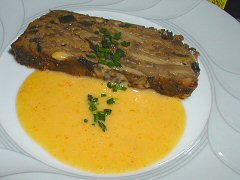 This recipe comes from Michael Lomonaco, a chef I know casually from New York from his days as the chef at the 21 Club, but it’s this really pretty incredible terrine. I had to change around some of the mushrooms from the original, just based on what’s available here in Buenos Aires – but essentially, I sauteed about two pounds of white mushrooms, porcinis, and dried shiitakes (reconstituted) with a couple of thinly sliced white onions, until they were almost dried, then added some triple sec, salt, black pepper, and the liquid from soaking the shiitakes, and continued to cook them down until all the liquid was evaporated. Spread them out in a pan and let them cool to room temperature, then add a cup of milk mixed with two beaten eggs and half a cup of cornmeal. Pour into a loaf pan and bake until firm – about an hour. Let it cool, turn it out onto a cutting board, and slice. The sauce was my idea, and based on the Japanese egg yolk sauce I’ve made before – it’s essentially a mayonnaise with the juice and grated peel of an orange, and a nice scoop of white miso in it. A little sprinkle of chopped chives and we have a pretty plate, no?
This recipe comes from Michael Lomonaco, a chef I know casually from New York from his days as the chef at the 21 Club, but it’s this really pretty incredible terrine. I had to change around some of the mushrooms from the original, just based on what’s available here in Buenos Aires – but essentially, I sauteed about two pounds of white mushrooms, porcinis, and dried shiitakes (reconstituted) with a couple of thinly sliced white onions, until they were almost dried, then added some triple sec, salt, black pepper, and the liquid from soaking the shiitakes, and continued to cook them down until all the liquid was evaporated. Spread them out in a pan and let them cool to room temperature, then add a cup of milk mixed with two beaten eggs and half a cup of cornmeal. Pour into a loaf pan and bake until firm – about an hour. Let it cool, turn it out onto a cutting board, and slice. The sauce was my idea, and based on the Japanese egg yolk sauce I’ve made before – it’s essentially a mayonnaise with the juice and grated peel of an orange, and a nice scoop of white miso in it. A little sprinkle of chopped chives and we have a pretty plate, no?
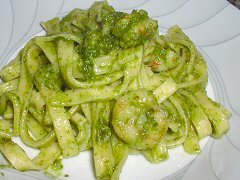 What, you may ask, is a Winter Pesto? I don’t know that there’s any official definition, even if there were anyone to proclaim anything officially about recipes. But generally, I’ve found that chefs who talk about winter pesto mean that they’ve added some sort of winter greens into the mix to make up for that it’s hard to get a lot of good, fresh herbs in the winter season. In this case I went with, more or less my own pesto recipe, just adding in a couple heads of escarole that I’d blanched and shocked – gotta preserve that bright green color – and just a little basil – also, since I was planning on this being a seafood pesto, I left out any cheese – so it was the escarole, basil, pinenuts (lightly toasted), olive oil, and lots of garlic – lightly warmed, just enough to take a little of the raw flavor out of the garlic. Fresh fettucine rather than dried, made by one of my local shops – they do it better than I do – and some small shrimp sauteed in olive oil tossed in at last minute. It works…
What, you may ask, is a Winter Pesto? I don’t know that there’s any official definition, even if there were anyone to proclaim anything officially about recipes. But generally, I’ve found that chefs who talk about winter pesto mean that they’ve added some sort of winter greens into the mix to make up for that it’s hard to get a lot of good, fresh herbs in the winter season. In this case I went with, more or less my own pesto recipe, just adding in a couple heads of escarole that I’d blanched and shocked – gotta preserve that bright green color – and just a little basil – also, since I was planning on this being a seafood pesto, I left out any cheese – so it was the escarole, basil, pinenuts (lightly toasted), olive oil, and lots of garlic – lightly warmed, just enough to take a little of the raw flavor out of the garlic. Fresh fettucine rather than dried, made by one of my local shops – they do it better than I do – and some small shrimp sauteed in olive oil tossed in at last minute. It works…
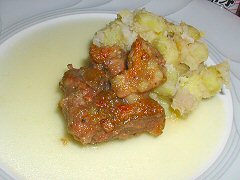 The main event… I wanted to roast a baby goat, a kid, a cabrito, or as they’re called here, a chivito. Now, I don’t have the room in the oven to roast one whole, so first I cut it up into pieces. Then I marinated it for the day in a puree of maple syrup, pears, salt, and black peppercorns. Then roasted until tender and a quick saute in a pan to brown it… that was night one… it was hard to eat, other than by picking up the pieces by the bone and munching… which no one seemed to want to do. Also, the portion sizes, especially after cooking, turned out very different… so the second night, I cut all the meat off the bone, into pieces about 2″ on a side or slightly more. Then I sauteed them to brown them, then added the marinade and cooked them until tender, and then used the broiler to brown them – I like the way that turned out much better. And to preserve that “bone” flavor – I took the bones and remaining meat and cooked them until browned, then added some water and made a concentrated broth, that I strained and finished with some butter and flour. On the side, a mix of diced potato, yam, and taro root, boiled first and then lightly sauteed in olive oil, with just some salt and white pepper. The first night we also had a couple of non-red meat eaters, so I did much the same thing with some salmon steaks – marinated and then pan roasted.
The main event… I wanted to roast a baby goat, a kid, a cabrito, or as they’re called here, a chivito. Now, I don’t have the room in the oven to roast one whole, so first I cut it up into pieces. Then I marinated it for the day in a puree of maple syrup, pears, salt, and black peppercorns. Then roasted until tender and a quick saute in a pan to brown it… that was night one… it was hard to eat, other than by picking up the pieces by the bone and munching… which no one seemed to want to do. Also, the portion sizes, especially after cooking, turned out very different… so the second night, I cut all the meat off the bone, into pieces about 2″ on a side or slightly more. Then I sauteed them to brown them, then added the marinade and cooked them until tender, and then used the broiler to brown them – I like the way that turned out much better. And to preserve that “bone” flavor – I took the bones and remaining meat and cooked them until browned, then added some water and made a concentrated broth, that I strained and finished with some butter and flour. On the side, a mix of diced potato, yam, and taro root, boiled first and then lightly sauteed in olive oil, with just some salt and white pepper. The first night we also had a couple of non-red meat eaters, so I did much the same thing with some salmon steaks – marinated and then pan roasted.
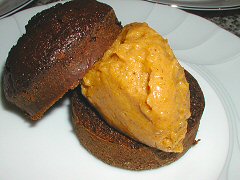 This is the only dish that radically changed between days… well, maybe not radically. The cake didn’t change at all – I wanted a good fresh ginger cake, and my online pastry chef friend David Lebovitz came through with Dave’s Ginger Cake. Now, David wouldn’t want to hear it, but all I did rather than all the pots and pans involved was throw all the ingredients except the water/baking soda mixture and the flour into a blender, mixed those all up, added the flour a bit at a time, and then finished with the water mixture, then poured it into buttered and floured ramekins to make little cakes. I wanted to pair it with a pumpkin mousse – in this case softening some agar-agar in hot milk and honey, adding in egg yolks, then some roasted and mashed butternut squash, cinnamon, cloves, nutmeg, vanilla, and cooking until lightly thickened. Then folding it in with some whipped egg whites and sugar, letting it cool and then chilling it. The first night it didn’t quite firm up the way I wanted and I served it more like a sauce around the cake, the second night it firmed up nicely (I used gelatin and slightly more of it, and a little more time in the refrigerator), so I split the cakes in two and scooped the mousse on top. Much nicer that way.
This is the only dish that radically changed between days… well, maybe not radically. The cake didn’t change at all – I wanted a good fresh ginger cake, and my online pastry chef friend David Lebovitz came through with Dave’s Ginger Cake. Now, David wouldn’t want to hear it, but all I did rather than all the pots and pans involved was throw all the ingredients except the water/baking soda mixture and the flour into a blender, mixed those all up, added the flour a bit at a time, and then finished with the water mixture, then poured it into buttered and floured ramekins to make little cakes. I wanted to pair it with a pumpkin mousse – in this case softening some agar-agar in hot milk and honey, adding in egg yolks, then some roasted and mashed butternut squash, cinnamon, cloves, nutmeg, vanilla, and cooking until lightly thickened. Then folding it in with some whipped egg whites and sugar, letting it cool and then chilling it. The first night it didn’t quite firm up the way I wanted and I served it more like a sauce around the cake, the second night it firmed up nicely (I used gelatin and slightly more of it, and a little more time in the refrigerator), so I split the cakes in two and scooped the mousse on top. Much nicer that way.
And that’s the news from Casa SaltShaker’s Winter Solstice fest!
[…] from some favorites – the olive oil poached trout with romesco sauce and shaved avocado, a brussels sprout bisque, huatia sulcana, and chocolate-chili cake with chocolate-olive oil mousse. But, in the middle of […]
[…] Brussels sprout bisque – this dish has gone through several versions, mostly to make it a richer, thicker soup, mostly just by reducing the amount of added vegetable stock, but also to really punch up the flavor, by trying it out with chicken stock in place of vegetable, which works really well when we don’t have vegetarian folk joining us during the week. I decided to experiment with it and add in a little garlic and just a hint of chili, and it works even better. The book version will likely use those and chicken stock, with veg stock as an option. […]
[…] then into a beaten egg mixture – and it’s fried just like that. Served over a slice of mushroom terrine and surrounded by my version of a traditional Peruvian al ajillo sauce – basically I poach an […]
[…] Brussels sprout bisque with fried parsley and chili oil. […]
[…] stuffed mushrooms, mushroom galettes, king oyster mushrooms with polenta, raw mushroom salad, mushroom terrine (which has come back as an accompaniment several times), in wheat “risotto”, in […]